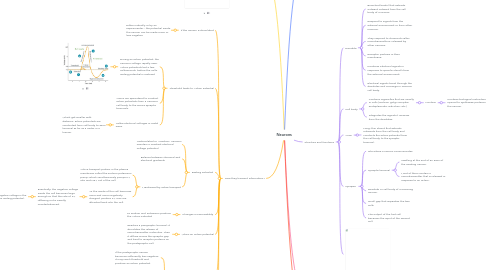
1. What are Neurons
1.1. Cells of the central nervous system
1.2. They have the ability to receive and decode information
1.2.1. In the form of electrical and chemical signals
1.2.2. Transmited to other cells.
1.3. Responsible for the transmission through the process of synapses
1.3.1. Synapses is the principle of the brain function.
1.4. k
2. How they transmit Information I
2.1. If the neuron is stimulated
2.1.1. Either naturally or by an experimenter , the potential inside the neuron can be made more or less negative
2.2. Threshold leads to Action Potential
2.2.1. During an action potential, the neuron’s voltage rapidly rises. Action potentials last a few milliseconds before the cell’s resting potential is restored
2.2.1.1. jj
2.2.2. Axons are specialized to conduct action potentials from a neuron’s cell body to the axon’s synaptic terminals.
2.2.3. Unlike electrical voltages in metal wires
2.2.3.1. Which get smaller with distance, action potentials are conducted from cell body to axon terminal as far as a meter in a human.
2.3. Resting Potential
2.3.1. Unstimulated or "inactive" neurons maintain a constant electrical voltage potential
2.3.2. Balance between chemical and electrical gradients
2.3.3. Maintained by active transport
2.3.3.1. Active transport protein in the plasma membrane called the sodium-potassium pump, which simultaneously pumps K+ into and Na+ out of the cell.
2.3.3.2. As the inside of the cell becomes more and more negatively charged, positive K+ ions are attracted back into the cell.
2.3.3.2.1. Eventually, the negative voltage inside the cell becomes large enough so that the rate of K+ diffusing out is exactly counterbalanced.
2.4. Changes in Permeability
2.4.1. To sodium and Potassium produce the Action Potential
2.5. When an action potential
2.5.1. Reaches a presynaptic terminal, it stimulates the release of neurotransmitter molecules. Then it diffuse across the synaptic gap and bind to receptor proteins on the postsynaptic cell.
2.6. Excitatory Postsynaptic Potentials (EPSPs)
2.6.1. If the postsynaptic neuron becomes sufficiently less negative, it may reach threshold and produce an action potential.
2.6.2. Such voltage changes “excite” the cell, possibly producing an action potential.
2.6.2.1. A
2.7. Inhibitory postsynaptic potential (IPSP
2.7.1. If the channels are permeable to K+
2.7.1.1. Then K+ ions diffuse out of the cell, making it more negative.
2.7.1.2. Making the cell more negative tends to inhibit the production of action potentials in the postsynaptic cell
3. How they transmit Information II
3.1. Synaptic terminal
3.1.1. It contains many neurotransmitter-filled vesicles. When an action potential enters the synaptic terminal, the vesicles release their neurotransmitter into the space between the neurons.
3.1.1.1. Then the neurotransmitter diffuses rapidly across the gap and binds to receptors on the postsynaptic cell.
3.2. Neurotransmitter
3.2.1. The neurotransmitter is“sent” across the gap, the presynaptic neuron sent it across this gap in order to communicate with the postsynaptic neuron.
3.2.1.1. When an action potential reaches the synaptic terminal, the inside of the terminal becomes positively charged.
3.2.1.2. The charge causes some of the vesicles to release neurotransmitter into the gap between the cells.
4. Structure and functions
4.1. Dendrite
4.1.1. Branched tendril that extends outward outward from the cell body of a neuron.
4.1.2. Respond to signals from the external environment or from other neurons.
4.1.3. They respond to chemicals calles neurotransmittors, released by other neurons.
4.1.4. Receptor proteins in their membrane.
4.1.5. Produces electrical signals in response to specific stimulli from the external environment.
4.1.6. Electrical signals travel through the dendrites and converge in neurons cell body.
4.2. Cell body
4.2.1. Contains organelles that are usually in cells (nucleus, golgi complex, endoplasmatic reticulum, etc.)
4.2.1.1. Nucleus
4.2.1.1.1. Contains biological instructions, rquired to synthesize proteins in the neuron.
4.2.2. Integrates the signals it recieves from the dendrites.
4.3. Axon
4.3.1. Long, thin strand that extends outwards from the cell body and conducts the action potential from the cell body to the synaptic terminal.
4.4. Synapse
4.4.1. Site where a neuron communicates
4.4.2. Synaptic terminal
4.4.2.1. Swelling at the end of an axon of the sending neuron.
4.4.2.2. Most of them contain a neurotransmitter that is released in response to an action.
4.4.3. Dendrite or cell body of a receiving neuron.
4.4.4. Small gap that separates the two cells.
4.4.5. The output of the first cell becames the input of the second cell.
